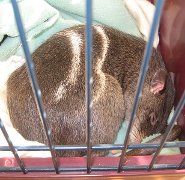 The Gambian pouched rat (Cricetomys gambianus) is truly one of the unsung heroes of the rodent world. Found wild throughout Africa; Gambian pouched rats weigh on average between 1 and 1.4 kilograms (2.2 and 3.1 lb). The length of this rodent can reach sizes of 64 to 91 cm (25.39 to 35.83 in) and beyond, including the tail. The Gambian pouched rat is brown or gray and may have white or lighter colored markings on its feet and belly. It is called a pouched rat because it has large storage pouches in its cheeks, much like a hamster. Omnivorous by nature, captive Gambian pouched rats thrive on a diet of vegetables, seeds, and grains in addition to commercial rodent kibble. In their native habitat of forests and thickets, Gambian pouched rats feed on palm kernels, insects, crabs, and snails. They are a nocturnal animal with keen hearing and smell but poor eyesight. In Africa, they are considered "bushmeat" and commonly captured and eaten. The species is quite common on the African continent and is not endangered.
The Gambian pouched rat (Cricetomys gambianus) is truly one of the unsung heroes of the rodent world. Found wild throughout Africa; Gambian pouched rats weigh on average between 1 and 1.4 kilograms (2.2 and 3.1 lb). The length of this rodent can reach sizes of 64 to 91 cm (25.39 to 35.83 in) and beyond, including the tail. The Gambian pouched rat is brown or gray and may have white or lighter colored markings on its feet and belly. It is called a pouched rat because it has large storage pouches in its cheeks, much like a hamster. Omnivorous by nature, captive Gambian pouched rats thrive on a diet of vegetables, seeds, and grains in addition to commercial rodent kibble. In their native habitat of forests and thickets, Gambian pouched rats feed on palm kernels, insects, crabs, and snails. They are a nocturnal animal with keen hearing and smell but poor eyesight. In Africa, they are considered "bushmeat" and commonly captured and eaten. The species is quite common on the African continent and is not endangered.In the United States, the Gambian pouched rat is kept as a pet, although it is no longer legal to import specimens. Populations of Gambian pouched rats have become a problem in the Florida Keys where they have gained a toehold in the wild.
In 1996, Bart Weetjens began to experiment with Gambian pouched rats in detecting land mines. Weetjens sought a low-tech method of dealing with the problem of land mines and drew on his childhood experiences with pet rats. Gambian pouched rats have keen sense of smell and can be very docile if they are handled from a young age. Weetjens collaborated with the Belgium Directorate for International Cooperation and established APOPO, a nonprofit organization that trains mine detecting rats in Tanzania. Known as HeroRATS, Gambian pouched rats are trained to smell out explosives. When the rat scratches a patch of ground containing a land mine, a clicker is pressed and the animal receives a food reward.
Gambian pouched rats are also used to detect tuberculosis. Laboratory rats identify sputum samples infected with tuberculosis in a similar manner to rats trained to identify land mines. One rat can work its way through as many as 150 sputum samples in 30 minutes. Tuberculosis is a major health concern in Africa and early detection of the disease is crucial to successful treatment. Gambian pouched rats have been an economical and effective tool in fighting the spread of this disease.
Picture by Liftarn, licensed under the Creative Commons Attribution-Share Alike 3.0 Unported license
The Gambian rat is listed as Least Concern. Does not qualify for a more at risk category. Widespread and abundant taxa are included in this category, on the IUCN Red List of Threatened Species
Namings for the Gambian rat
A young / baby of a Gambian rat is called a 'kitten, nestling, pinkie or pup'. The females are called 'doe' and males 'buck'. A Gambian rat group is called a 'colony, horde, pack, plague or swarm'.Countries
Angola, Benin, Botswana, Burkina Faso, Burundi, Central African Republic, Chad, Congo, Democratic Republic of the, Congo, Republic of the, Cote d'Ivoire, Gabon, Gambia, The, Ghana, Guinea, GuineaBissau, Kenya, Malawi, Mali, Mauritania, Mozambique, Niger, Nigeria, Rwanda, Senegal, Sudan, Tanzania, Togo, Uganda, Zambia and ZimbabweGambian rat habitats
Arable Land, Artificial / Terrestrial, Dry savanna, Forest, Plantations, Rural Gardens, Savanna, Subtropical / Tropical Moist Lowland, Subtropical / Tropical Moist Montane and Urban AreasSome facts about the
Gambian rat
Adult weight : 1.5 kg (3.3 lbs)
Maximum longevity : 8 years
Female maturity :158 days
Gestation : 34 days
Weaning : 31 days
Litter size : 4
Litters per year : 4
Weight at birth : 0.026 kg (0.0572 lbs)
Basal metabolic rate : 6 W
Body mass : 1.687 kg (3.7114 lbs)
Temperature : 35.85 °C (96.53 °F)

Custom Search